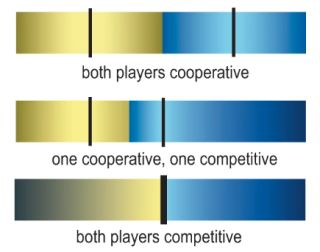Teamwork
The Science of Choosing Between Cooperation and Competition
New work shows brain activity when deciding how cooperative to be.
Posted December 16, 2022 Reviewed by Gary Drevitch
Key points
- Every day, we make decisions to cooperate with others but sometimes we feel the need to compete.
- New research suggests that we constantly adjust how cooperative to be.
- Specific parts of the brain monitor our partners’ cooperation level and respond by changing how competitive we are.

By Andrea Pisauro, Ph.D. and Matthew Apps, Ph.D.; edited by Patricia Lockwood, Ph.D., and Jo Cutler, Ph.D.
We live in the most peaceful time in our species’ existence and global cooperation has expanded to unprecedented levels. Yet, sometimes cooperation breaks down and we witness unexpected conflicts. Psychologists, economists, and political scientists have long sought to understand when and why people compete rather than cooperate. A new study that looked at what happens in the brain when people make these decisions revealed fascinating new insights.
Economic Games
Interacting with others is complicated. We have to think about what we want, what other people want, what setting we are in, and then combine that information to decide how to behave. A key aspect is whether to be friendly or hostile. The complexity of social decisions makes it hard for scientists to understand how people choose between cooperating or competing. To solve this, scientists created games which simplify the interactions people have. In these games, players can get money, but the amount depends on both what they and other players choose.
A classic of this type of "economic game" that probes people’s decisions about whether to cooperate with each other is the Prisoner’s Dilemma. It goes like this: Two prisoners are interrogated by the police in separate rooms about a crime they have committed together, but for which the investigators have no evidence. If they both cooperate and refuse to confess, they might get away with it. However, if one of the prisoners betrays their accomplice, the one who chose to cooperate will be heavily punished, while the “defector” will walk away freely. Defecting can therefore seem appealing. Yet, there is a risk: If both accuse each other, investigators will send both to prison. This story became a game for two players. Both win some money if they each cooperate but are tempted to betray their partner to get more money (at the expense of the partner). However, if both players betray each other, neither receives any money.
Researchers have shown that people usually choose to cooperate in the Prisoner's Dilemma, even when they know they’ll never meet the other player again. When playing multiple times with the same person, players tend to retaliate after occasional betrayals, which in the long term also reduces the chances of further betrayals. This website allows you to play the game, and see for yourself how different attitudes toward cooperation can evolve over time in a population.
The prisoner’s dilemma has been really powerful to help researchers understand many different aspects of what makes people choose to cooperate, but it has limits. People always have to choose between only two options: cooperate or not. But in everyday life, things are not that simple. If a colleague is being difficult and then asks for help, we might not want to “fully” cooperate, but we also might not be too competitive. We might be a little bit cooperative to maintain harmony at work, but not expend too much energy being really helpful. How do people decide how cooperative to be? And how do they adjust their cooperation over time?
Measuring continuous changes in cooperation: The Space Dilemma
In our recent study published in Nature Communications, 54 volunteers played a new game in which they could be fully cooperative, fully competitive, or somewhere in between. We did this by getting two players to make decisions about where to position themselves in a virtual two-dimensional space where a reward would suddenly land. The person who was closest to the reward location won that round and the closer that winner was, the more money they received. Where the reward landed in the space was completely random. That meant players who put themselves in the middle were being competitive as they increased their chances of winning. However, the actual amount they won on average would usually be low, as the reward would often land far from the middle. On the other hand, the two players could cooperate by putting themselves at opposite ends of the space. In this case, each person’s chances of winning an individual round go down but when they do win, it will be a larger amount so they will earn more money across many rounds of the game. As in the Prisoner’s Dilemma, this only works if both cooperate. If one goes to one end while the other tries to win in the middle, the latter will win much more often at the expense of the former. On each round, participants simply put themselves somewhere in the space, but they did this before seeing where the other player went. As participants levels of cooperation or competitiveness were measured by their location in the space, we called our new game the “Space Dilemma." We created different versions of the game, discouraging cooperation by gradually increasing the amount of money given to the winner and, conversely, the punishment for the loser.

People constantly adjust how cooperative they are
People were generally cooperative, but they became increasingly competitive when we boosted the amount they would lose if they got betrayed. They also constantly adjusted their response to the other players’ level of cooperation. We used a mathematical model to calculate how surprised a player would be at the other person’s position. We found that even when the position of the other player was just a little more competitive than expected, it led people to adjust their own position on the next round, making themselves more competitive.
One of the two participants played the game while we scanned their brain. We found that an area called the right temporal-parietal junction (TPJ) signalled how surprised players were at the other person’s level of cooperation. Parts of the medial prefrontal and cingulate cortex – brain areas linked to both making decisions and understanding others — put the surprise in context of how much money could be lost if they got betrayed, and guided decisions about how cooperative to be next time.
This study shows how people continuously adjust how cooperative they are, as the brain constantly monitors and reacts to others’ social behaviour. More generally, understanding what facilitates cooperative behaviours is essential for increasing people’s well-being and to ultimately reduce international conflicts and increase peace.
References
Fehr E, Schmidt KM. A theory of fairness, competition, and cooperation. Quarterly Journal of Economics. 1999;114(3). doi:10.1162/003355399556151
Rand DG, Nowak MA. Human cooperation. Trends in Cognitive Sciences. 2013;17(8):413–425. doi:10.1016/j.tics.2013.06.003
Stallen M, Sanfey AG. The cooperative brain. Neuroscientist. 2013;19(3). doi:10.1177/1073858412469728
Pisauro MA, Fouragnan EF, Arabadzhiyska DH, Apps MAJ, Philiastides MG. Neural implementation of computational mechanisms underlying the continuous trade-off between cooperation and competition. Nature Communications. 2022;13(1). doi:10.1038/s41467-022-34509-w
Flood MM. Some Experimental Games. Management Science. 1958;5(1). doi:10.1287/mnsc.5.1.5
Capraro V, Jordan JJ, Rand DG. Heuristics guide the implementation of social preferences in one-shot Prisoner’s Dilemma experiments. Scientific Reports. 2014;4. doi:10.1038/srep06790
Axelrod R, Hamilton WD. The evolution of cooperation. Science. 1981;212(4489):1390–1396. doi:10.1126/science.7466396


